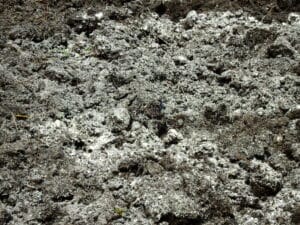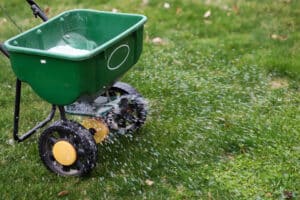Moss in your yard isn’t necessarily harmful, but it can be an unwelcome sight for homeowners who prefer a lush, green lawn. Unlike grass, moss thrives in shady, damp, and compacted soil conditions, often signaling underlying issues with drainage, pH balance, or lawn health. While some gardeners intentionally cultivate moss for its soft texture and low maintenance, others find it invasive and difficult to control. Fortunately, removing moss is straightforward with the right approach, whether you choose natural remedies like dish soap or chemical treatments designed to eliminate it quickly.
The key to keeping your lawn moss-free is not just removing existing growth but also addressing the conditions that encourage it. Aerating compacted soil, improving drainage, adjusting soil pH, and ensuring your lawn receives adequate sunlight can all help prevent moss from returning. By taking a proactive approach, you can create an environment where grass thrives and moss struggles to take hold, leading to a healthier and more vibrant yard.
Get a Quote From Lawn Professionals Near You
Compare quotes from local pros

Lime Soil Amendment

Lawn Fertilization
What is Moss?
Moss is a flowerless, ancient plant that often grows in dense clumps or mats. It doesn’t have true roots and it isn’t actually detrimental to your grass. In fact, some people incorporate moss into their lawns on purpose.
However, the presence of moss could indicate that your lawn is struggling. Common causes for lawn moss include issues like excessive shade or soil problems—it can be compacted, have low soil pH, or poor drainage. While grasses suffer in these conditions, moss thrives. So even though moss won’t kill your grass, the conditions that support its growth can.
Getting Rid of Moss in Your Lawn Naturally
Moss isn’t like other weeds, so traditional weed killers won’t be effective against it. The most common way to get rid of moss naturally is by using dish soap. The best time to kill moss is when it’s actively growing, in late spring to early summer or late summer to early fall.
Using Dish Soap
Raking and Dethatching
Getting Rid of Moss in Your Lawn With Chemicals
The two most common ingredients in moss-killing chemicals are iron sulfate and glyphosate. Iron sulfate will start damaging moss in a matter of hours and effectively kill it within two days. This ingredient is commonly found in fertilizers and won’t harm your lawn’s grass.
Glyphosate, on the other hand, is non-selective and will kill both the moss and grass it comes into contact with.
How To Prevent Moss
If you want to prevent moss from taking up residence, make your lawn less hospitable to the weed. The best way to do this is by resolving the issues that may have led to the moss in the first place.
Excessive Shade
The precise amount of sun your lawn needs will depend on your region and grass type. On average, most lawns need about four to six hours of sunlight per day. If branches are casting a shadow over a large area of your lawn, prune them back. You can also switch to growing a grass that tolerates shade better, like tall fescue.
Low Soil pH
Send a sample of your soil to a university or your local cooperative extension. They can test the soil to determine if it has the proper nutrients and whether it’s alkaline enough. In general, a lawn’s pH level should be between 6.0 and 7.0. To make your lawn less acidic, you can apply lime. Soil amendments and regular fertilization are the key to a healthy lawn.
Poor Drainage
Drainage issues welcome moss. The type of soil you have can impact the likelihood of drainage issues—clay soil tends to puddle. However, you can amend the soil to make it easier for moisture to pass through.
Compacted Soil
Excessive foot traffic and thatch can compact your soil, preventing it from retaining a steady flow of nutrients, water, and air. You can rectify this by aerating, using a tool or machine to poke thousands of tiny holes into your lawn to let it breathe. Dethatching, or breaking up the layer of decomposing organic matter between grass blades and the soil, will also alleviate this issue.
DIY vs Professional Moss Removal
When it comes to getting rid of moss in your yard, you have two main options: tackling the job yourself or hiring a professional lawn care service. DIY moss removal can be an effective and budget-friendly approach, especially for homeowners dealing with small patches of moss. Simple solutions like a dish soap and water mixture can kill moss within a day, while manual methods like raking or dethatching help physically remove the dead growth. On the other hand, professional moss removal services offer a more comprehensive approach to tackling moss infestations, particularly for large or persistent problems. Lawn care companies use specialized equipment, such as power dethatchers and aerators, to remove moss efficiently while improving soil conditions.
Below are some of the pros and cons for using professional moss removal services:
Pros
- Bigger Issues: More effective for large or recurring moss problems
- Equipment: Uses specialized equipment like dethatchers and aerators
- Soil Treatment: Includes soil testing and long-term lawn care solutions
Cons
- Costly: The cost of professional lawn care is generally at least $50-60 per month.
- Scheduling: Requires scheduling and working with a service provider
- Chemicals: May involve chemical treatments that some homeowners prefer to avoid
Our Conclusion
Eliminating moss from your yard is only half the battle—maintaining a healthy lawn is the key to preventing it from returning. By addressing the underlying issues that allow moss to thrive, such as poor drainage, compacted soil, low pH, or excessive shade, you can create an environment where grass flourishes and moss struggles to grow. Whether you choose a DIY approach or enlist professional help, regular lawn care practices like aeration, proper fertilization, and soil amendments will keep your yard vibrant and moss-free in the long run.
FAQ About Getting Rid of Moss in Your Lawn
How do I get rid of moss in my lawn naturally?
You can get rid of moss naturally by using a solution of water and dish soap, or by raking it up if there’s just a small patch.
Why do I have so much moss in my lawn?
If you have a lot of moss in your lawn, the likely culprits are excessive shade, poor soil drainage, soil compaction, or a low soil pH.
Will lime kill moss?
Lime will not kill moss, but it will make the soil more alkaline, helping to prevent moss in the future.
Is it bad to have moss in your lawn?
It’s not necessarily bad to have moss in your lawn. Moss will not kill your grass, but it does indicate that your lawn has some issues that need correcting.
Our Rating Methodology
Our backs up our lawn recommendations with a detailed rating methodology that we use to objectively score each provider. We review lawn care plans and packages, navigate the provider website and speak with customer service representatives, request quotes, and analyze customer reviews for each provider. We then score the provider against our review standards for plan options, additional benefits and customizability, availability, trustworthiness, and customer service to arrive at a final score out of 100.

